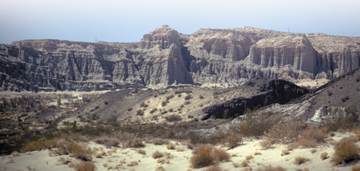 While
most seismologists tend to steer clear of the word “prediction,” several
international teams are working toward that “holy grail” of seismology.
One such team released a forecast in January, saying that an earthquake of at
least magnitude 6.4 would occur in Southern California before Sept. 5, 2004.
The announcement, made through a press release from the University of California
at Los Angeles (UCLA), has sent small tremors through the seismology community.
While
most seismologists tend to steer clear of the word “prediction,” several
international teams are working toward that “holy grail” of seismology.
One such team released a forecast in January, saying that an earthquake of at
least magnitude 6.4 would occur in Southern California before Sept. 5, 2004.
The announcement, made through a press release from the University of California
at Los Angeles (UCLA), has sent small tremors through the seismology community.
Red Rock Canyon in the Mojave Desert may feel some shaking sometime soon — or not. One research group forecasts an earthquake to occur there before Sept. 5, 2004. Copyright Jerome Wyckoff and courtesy of the Earth Science World Image Bank.
Led by Vladimir Keilis-Borok, who started his career in Russia and established the International Institute of Earthquake Prediction Theory and Mathematical Geophysics in Moscow, the team developed the method with colleagues from around the world. The system “works like a country doctor: He tests your pulse, temperature, blood pressure, such things — and using what he knows, he decides if you are going to collapse or not,” says Keilis-Borok, who is currently in residence at UCLA.
Combining mathematical modeling, nonlinear geodynamics and pattern recognition, Keilis-Borok and his team examine such characteristics as the distribution and time intervals of small earthquakes, fault networks, and stress and strain as best as they can be measured. The researchers also consider magnitude and position of all earthquakes in different-sized areas within a region. Feeding these criteria into their algorithms, they can then work out a “time of increased probability” for a large earthquake in a region. They have built several algorithms, including for Sumatra and for Northridge, Calif.
The researchers have tweaked their system over decades, publishing descriptions in the Proceedings of the National Academy of Sciences and elsewhere. Some of their past forecasts have also been published, and the team’s current prediction has been submitted to the journal Physics of the Earth and Planetary Interiors.
The September 2004 prediction covers a large swath of Southern California, including a portion of the Mojave Desert. “It includes a number of active faults that could potentially generate large earthquakes,” says John Vidale, a seismologist who is also at UCLA but who does not work directly with Keilis-Borok. “It is a place people, including myself, would argue is ready to go.”
Vidale notes that Keilis-Borok’s team has had some success in “hindcasting” past large earthquakes, and they have made at least two accurate forecasts of large earthquakes, including the earthquake that struck central California’s coast last Dec. 22. But he says that predicting two events represents a small statistical sample, and “the community will be fairly skeptical.”
Keilis-Borok himself is very careful to underscore that the current event window they hypothesized is not quite a prediction of an earthquake, but instead a test of the system. “Until we have a lot of successful predictions, we cannot tell that the method is correct,” he says. And although the probability of the September event occurring is unclear, Keilis-Borok says that it is significant. “It could be 50 percent,” he says.
That success rate, if true, would be “very good” compared to current long-term forecasts, says Tom Jordan, director of the Southern California Earthquake Center. The center convened a workshop to discuss the scientific basis of Keilis-Borok’s method on Feb. 20.
Jordan says that a key question is whether prediction will help the public, “given the large area of southern California involved and the high probability of a false alarm.” Even though a warning would allow for some public safety preparations and prioritization of seismic retrofitting in a region, such forecasts could also affect earthquake insurance and other related concerns. “We have to be extremely careful in this earthquake prediction business,” Jordan says, which has been generally unsuccessful so far.

